How We Financed, Produced and Released Our Short Film, tender
Oct 17, 2023
This is a guide about the making, marketing, and distribution of tender, a short film written and directed by our Head Storyteller, Felicia Pride alongside the most amazing cast and crew. And, how the most amazing team of Black women went about releasing it in 2020… yep during the pandemic.
To learn more and to watch tender, visit www.tendermovie.com.
inception of tender
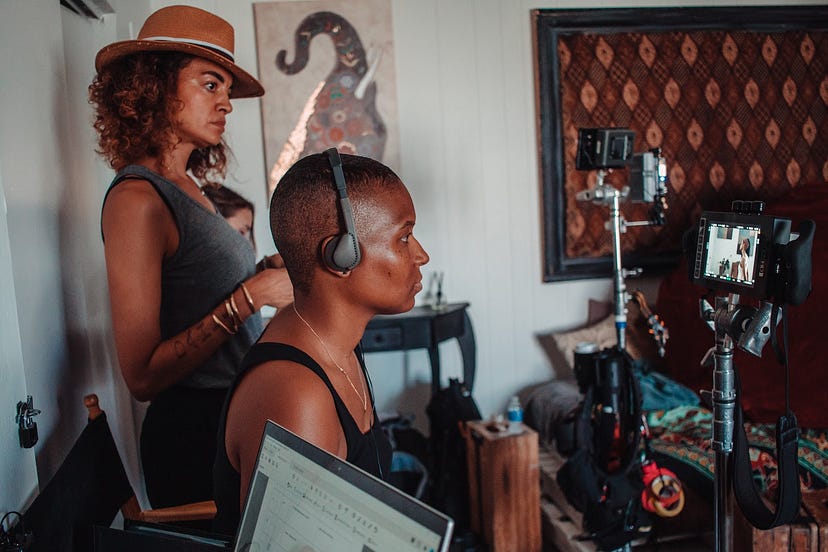
Behind the scenes of tender; credit: Avery Archie
For a long time, I told myself I couldn’t direct. That I didn’t see like a director. One of those false narratives that we tell ourselves. But I realized that for certain stories, I have to be a part of the vision through from start to finish. Even though I was terrified of directing tender, I’d learned that film is a director’s medium and in order to protect the very clear vision I have for certain projects that I birth, I knew I’d have to step into the director’s chair and get over my fears.
So tender is my directorial debut. It’s a little baby, but in it, I wanted to explore the bonds between Black women. I know I’ve been fortified and saved and cared for and loved by the Black women in my life. I wanted to try to capture that sentiment.
I also wanted to explore our sexuality and our desire. So often our sexuality is shamed or exploited or lacks nuance or looks only one way. We don’t see enough queer relationships, relationships where Black women have agency… We deserve a plethora of stories that reflect our desire and sexuality in all of its shapes and forms.
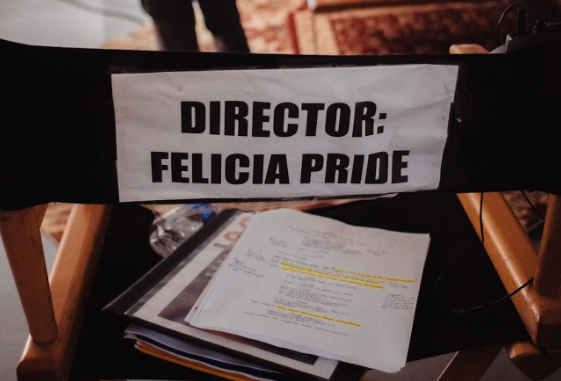
Our awesome producer made this sign for me
financing
We wanted tender to be the first project out of Felix and Annie, my Gen-X focused production company. However, I didn’t have the money to finance it myself (like most filmmakers). So we decided to launch a hybrid fundraising campaign that included crowdfunding and paid virtual events.

Our Crowdfunding Campaign
Crowdfunding is a great way to build an audience for your film from day one. We knew this was a strategy that we’d use from the get-go so that once the film was complete, we would have people invested in watching it. But crowdfunding can be hella stressful. Having a very well-thought out campaign to draw as many eyes to the project is key. We handled the execution of our hybrid campaign ourselves, but you could also outsource if you feel you need the additional push.
Narrative Drive Behind The Campaign
One very important element that made the tender crowdfunding campaign a success was the narrative drive behind it. I had this intense fear of stepping into the director’s chair and as I began sharing that with people, I realized that it was a fear that a lot of other writers and creators shared. So we used that commonality as a narrative drive for the campaign.
Length of the Campaign
Because we had our shoot date in mind when we went into the crowdfunding stage, we knew exactly how long we would crowdfund, which was four weeks.
The Platform We Chose
Crowdfunding tender wasn’t something that we planned for a long time. There had been a lot of self doubt and fear prior to me deciding to actually shoot tender, and once I made the decision to move forward, we didn’t have a lot of time to prep and plan. We were sort of thrust into campaign mode, so we decided to go with GoFundMe because it didn’t require perks and you could get money immediately. Since we were in pre-production while crowdfunding, it was important to be able to access funds.
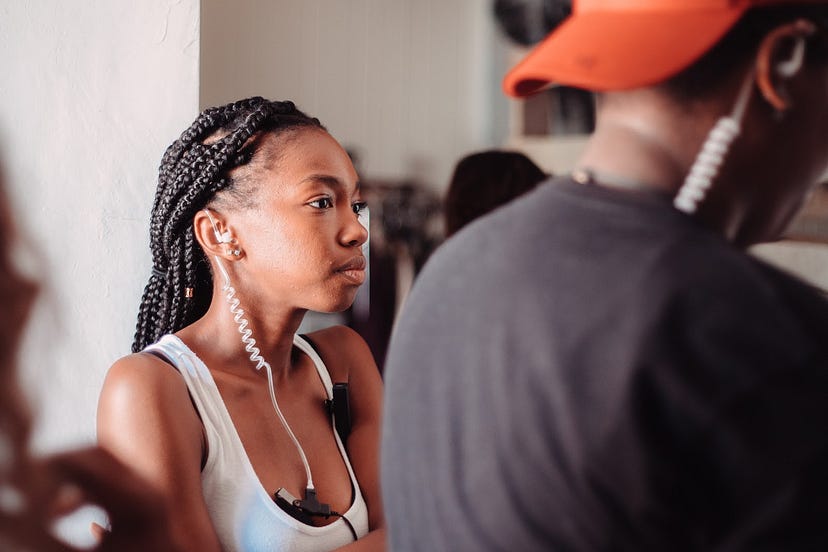
Our awesome producer Regina Hoyles; credit: Avery Archie
Budgeting
Prior to launching the crowdfunding campaign, we had commissioned a budget from a line producer. This step was vital so that we knew how much it would cost to produce tender. This budget was adjusted by our producer, Regina Hoyles, as we went into pre-production, but having a good prediction of what costs to expect upfront was vital to setting our crowdfunding goal.
Speaking of our goal, we intentionally set our goal on GoFundMe to be modest and only half of what we really needed: $5,000. This was so that we could have a better chance at reaching this initial goal, gaining the trust of donors, and then work towards a stretch goal. And we were able to surpass our goal and ended raising nearly $15,000 in total from our campaign. Here’s how we did it.
Ways We Raised Money
There were three prongs that helped us reach our fiscal goal.
GoFundMe
The primary way we raised money for tender was through GoFundMe. In order to promote our GoFundMe, we developed an editorial calendar to guide what we were going to post for our campaign on a daily basis. We used Trello to outline the calendar. It was a great way for our team to stay organized and be on the same page at all times. We promoted our crowdfunding campaign nearly every day — trying to find fresh ways to do so each time.
We created graphics and other creative assets for social media that had the look and feel of tender. You don’t have to be a graphic designer or hire one. We used drag-and-drop platforms like Canva to design high-quality shareable graphics. We made sure to update graphics as the campaign aged. For example, once we reached our initial goal, we created a graphic thanking our donors but also upping our goal and encouraging people to help us reach our stretch goal.
There was also a section dedicated to tender with a link and graphics directing visitors to the campaign on our tender website, which we created quickly as a page on our Felix & Annie website.
We also made sure to keep our donors engaged and updated on tender by sending them messages throughout the campaign. It was important to keep our donors updated on the project’s journey along the way because they were our biggest campaign sharers and cheerleaders.
Another element that we can contribute to the success of the GoFundMe page was setting a date for production. Because we had a tangible shoot date that we shared, people felt like they only had a certain window to donate. It created a sense of urgency and made people feel like it was now or never. They also felt more confident in donating because they knew there would be an end product that they could watch and share soon.
Fiscal Sponsorship
Another way we raised money for tender was through fiscal sponsorship. We used Film Independent to help execute this prong of the campaign because we knew some wealthy individuals who would be interested in using their donation as a tax writeoff. We ended up raising about $3,000 through this method.
For higher donors, we offered an even more personal touch. We picked up the phone and made calls. Crafted personal emails that exuded passion, vision, and sincerity. We didn’t spam folk. Consider creating a list of people who you have relationships with and people you believe will genuinely connect with your project. Research and see if you can find people who have a history of donating to projects similar to yours.
If you have a lookbook (which we did), you can share it with your potential donors so they can see what you’re aiming for visually.
Virtual Chats
After having executed a past crowdfunding campaign that did not turn out successful, I knew I wanted to do something extra to boost the tender campaign. Since we weren’t offering perks because of our time crunch and limited capacity, we also wanted to provide an avenue for donating where people felt like they were getting something tangible for their donation.
Since I run The Create Daily, a free online service where I help underrepresented storytellers thrive, I knew a lot of fellow creators would find value in a series of webinars.
So we launched Virtual Chats, one-hour webinars/Q&As around writing and the entertainment business. We hosted three chats, weekly during the month-long campaign: The Art of Pitching for Film and TV, Developing A Writing Process, Practice & Schedule, and What It Takes to Become A Professional Film/TV Writer, which are all still available online. We charged $25 for each webinar and allowed people to donate on top of their ticket if they wanted. All proceeds went to the making of tender. We also made the chats available online and now proceeds go toward the making of tender, the feature film.
producing
Since this was my first film, I knew it was going to be crucial to work with a producer whom I could trust and who understood the vision for the film. Luckily, I found that in Regina Hoyles. Regina was my right hand for about a year prior. She wrote, directed, and starred in her own short film, Adullum. I saw it and was so impressed. So I asked her if she would produce tender. And she was perfect because she already knew my aesthetic and what was important to me. And she knew how to talk me off a few ledges!
Hire A Producer
You don’t want to do this yourself. An experienced producer comes at a cost, but they make production easier so you can focus on the execution of your vision. Producers help with casting, crew, paperwork, locations etc — anything dealing with pulling the production together.
Me and our awesome DP Ludovica Isidori
Finding Your DP
The next steps after getting our producer on board was to secure our DP, or cinematographer on board. Ludovica Isidori was incredible to work with. We met 3–4 times before production to talk about vision, inspiration, motivation, and most importantly, story. She used the lookbook I created as a jumping off point. Then we began to create a shot list. Ludo created her own lookbook, which covered lighting and how we would physically move through the film, as well as specific shots we knew we wanted to capture. Because we put in this preliminary work, when we got on set, we were very clear on the vision.
Vet Your Department Heads
Since we were on a time crunch with tender, we didn’t have time for a full-on meeting with each department. But I did make sure to talk to each department head to get a feel for them, for how they saw the project, and honestly, to make sure they weren’t nutty. One thing I was conscious of doing was giving each department head autonomy once I felt confident that they were clear on the vision. I wanted them to feel free to translate that vision through their own unique way of expressing story.
tender is a story about the intimacy between Black women. It was important that the vast majority of our crew was women, especially Black women. It was so crucial to have a woman behind the camera lensing the intimacy.
releasing
I used to work as an impact producer and film distribution executive. I believe that distribution is as important as production. But sometimes, distribution is an afterthought and it shouldn’t be. My mission isn’t just to tell certain stories, but also to work to get the stories to the audiences they were intended for.
Build A Team
We wanted to pour the same amount of resources, womanpower and time into the release as we did production. Luckily, our producing team also became our release team. If you can, try to budget for marketing and distribution, including line items for film festival submissions, DCP’s, etc.
You can also hire to fill in areas where you may not be well versed. If you’re not big on social media, you can look to work with someone to handle posting and engaging during the campaign. We had a couple of people who graciously volunteered their time throughout different stages of tender because they wanted to learn more about the process.
In terms of how we handled our release: I developed the campaign strategy and oversaw its execution. Regina Hoyles, the producer of tender, handled all festival submissions and media delivery, which is a lot of work and time. Felix & Annie Creative Exec, Amber Brown managed our promotional content calendar throughout the release campaign and created the digital assets (graphics, videos, GIFs) we used to promote the film on social media.
I felt like publicity was going to be crucial to help get the film seen. So I teamed up with Jasu Sims of PRessTheory, whom I worked with before on another film release. She’s a beast and we work really well together. She put together a publicity plan based on our release goals. We identified the various audiences we wanted to reach and she matched publications with those targets. Not all publicists are built the same. It’s important they are able to understand and work specific angles related to your projects, have media relationships (or willing to build them), and excel at the fine art of follow-up. Likewise, it’s important to understand what publicity can and can’t do and to manage expectations.
Jasu was critical to the roll out of the campaign because she put in the legwork for all the press the tender release received. She was able to score us coverage in several outlets and book interviews for outlets and podcasts like The Root, The Grio, Therapy for Black Girls, which led to placements in places like Glamour and AutoStraddle.
Set An Intention For Your Campaign
You have to decide what you want to achieve by releasing your film online prior to designing your campaign because it will greatly affect how you roll it out.
Additionally, there are three elements you need to be clear on before you construct your campaign: Campaign length, goals you want to accomplish, and strategies for executing the campaign. Each element determines the others.
Goals of tender Campaign
Before you strategize for your campaign, spend time focusing on what your goals for the campaign to be. We had two goals for this online release. One was so that every creator involved could use it as a calling card. tender also became an amazing proof of concept for a feature version of the film.
The second goal of this campaign was to get as many people to view the film as possible. Monetization is another goal you could have when designing the campaign for your film’s release, but it was not our focus because oftentimes monetization can limit the amount of people who see a film.
Length of tender Campaign
We decided it would be smarter to capitalize on the urgency and excitement of the launch, by compressing it to a one-month period. The film would still be available online post the campaign and we planned to continuously promote it on social media, but the hardcore push would be concentrated in a four-week period.
Note that just like with a crowdfunding campaign, the middle of your release campaign will likely plateau. In the third week of the tender campaign, we definitely saw a decline in daily views. However, they never went completely stagnant, which at this phase in the campaign is what’s important. We also observed that while the numbers had slowed down, the breadth of our reach was growing. We were being watched in over a dozen countries. tender had found its audience and it was still being viewed and shared.
Still, the slump can be slightly (discouraging). So this is where your most exciting anchors come in. We positioned our most exciting piece of promotional content (more on this later), at the end of our third week because we anticipated this slump in excitement. It also set us up nicely for the final leg of the campaign.
rollout of the release campaign
The tender Strategy
Strategy is key, but your strategy should reflect your goals. Different goals will absolutely require different strategies. Because our primary goal was to have as many eyes on tender as possible as opposed to monetization, we did several specific things.
Our initial release strategy for tender was to have a windowed approach where we’d start with film festivals, then move to online after our film festival run. We were so proud to premiere at Outfest Fusion, a week before things shut down. But as the pandemic raged on, I thought it would be an opportunity to release tender online because people were in a position to watch it more easily. So we came together as a team and decided to release tender the first week of May. And just like we did with crowdfunding, we developed a four-week campaign strategy to guide our release.
We knew this decision was possibly sacrificing film festivals because sometimes they don’t want to screen films that are already online. But because of the pandemic, most film festivals still screened shorts that were also online, so we were able to enjoy a healthy film festival tour alongside our online release.
Released on Vimeo
We decided we would release the film on Vimeo because it’s very accessible, but also there’s a perceived cache with the platform for short films. We’re considering releasing on YouTube as a way to jumpstart our campaign to turn tender into a feature.
Find A Release Partner
Since our goal for tender was exposure, exposure, exposure, we knew we would want to find a partner whose audience would enjoy our film. This way we are extending the amount of people who the film is exposed to. Our release partner was the media outlet Shadow & Act who was given the exclusive online premiere of tender. We reached out to an editor at Shadow & Act because we noticed that they were premiering more and more short films online, so we asked if they’d premiered ours, and the answer was yes! A few days before the online premiere, we created a teaser for the film and teased that the release was coming.
Anchor Content
We developed our release campaign around what we called anchor content, high quality content that had the potential to drive bigger numbers of people to view our film, as opposed to daily social media posting. The best anchor content are pieces that provide value, can be repurposed beyond the campaign window and are shareable, which can extend your audience tremendously.
Since the tender campaign would be one month long, we developed one anchor for every week of the release in advance.
- Week 1: Virtual Watch Party + Q&A with Cast & Crew where we live-tweeted as attendees collectively screened the film online and followed it up with a live Q&A session with cast and crew on Zoom.
- Week 2: Playlist release. Music is playing in every scene except one in tender and is one of the elements our audience connected with the most. So we released an extended soundtrack for the film via a Spotify playlist that was curated by Asha Santee and BOOMscat, the artists behind the music in the films.
- Week 3: tender Case Study. This was an informative webinar where we partnered with Black Film Space, an online hub dedicated to enhancing the carers of Black filmmakers, and shared our process of taking tender from a concept to a released film. We recorded the session, which turned it into an evergreen piece of content that we can continuously share beyond the campaign.
Other anchor content ideas include releasing the script to your film or unreleased behind-the-scenes footage/photos.
Develop An Editorial Calendar
The release campaign can be overwhelming at times. There’s tons to do always, so organization is key. Having a planned-out editorial calendar filled with daily promotional content will go a long way. It’s especially convenient if you can schedule posts ahead of time. You can set up mini campaigns inside your film release campaign for your anchor pieces of content to get people excited and sharing.
After the tender campaign was launched, we continued to create new digital assets to share on social media and to our email list.
Track the Film’s Views
We made sure to keep track of the views the film was getting daily, including where they were coming from. We got most of our views from the initial Shadow & Act announcement, so we made sure to keep promoting that piece.
Tracking is also useful to measure your success throughout your campaign and make necessary adjustments to ensure that you are steadily moving toward your goals.
Don’t Be Overwhelmed By The Concept of Marketing
If you don’t have experience in marketing, it can definitely seem quite overwhelming at the onset. But we are in the business of storytelling, right? So view your marketing campaign through the same lens.
The most successful marketing campaigns inspire action because they make you feel something. The best way to make people feel is to tell a compelling story. Create a narrative behind your campaign, a drive. The most effective way at bringing audiences to the story is to involve them in the story. Make it feel personal. Make it compelling.
When it comes to reaching your audience, start with who you think your film is primarily for. You know your film better than anyone, so use that to develop a profile for your ideal audience. Where do these people live online? What are they interested in? Who do they follow?
Of course, in the best case scenario, your film will be embraced by other audiences and that’s amazing. But going into developing a marketing campaign, be specific. Craft a campaign that your audience will connect to on a genuine level.
Towards the end of our campaign, tender aired on STARZ, live and on demand via its app. This distribution opportunity was the result of winning the Lionsgate / STARZ award at the BlackStar Film Festival.
tender release highlights and wrap-up
I am so proud of how we rolled out the release of tender. It was intentionally, specific, and gave our film, which we poured our hearts into, the time and attention its release deserved. Our publicist Jasu developed a campaign wrap report analyzing the numbers behind the campaign. Here are some highlights from our release.

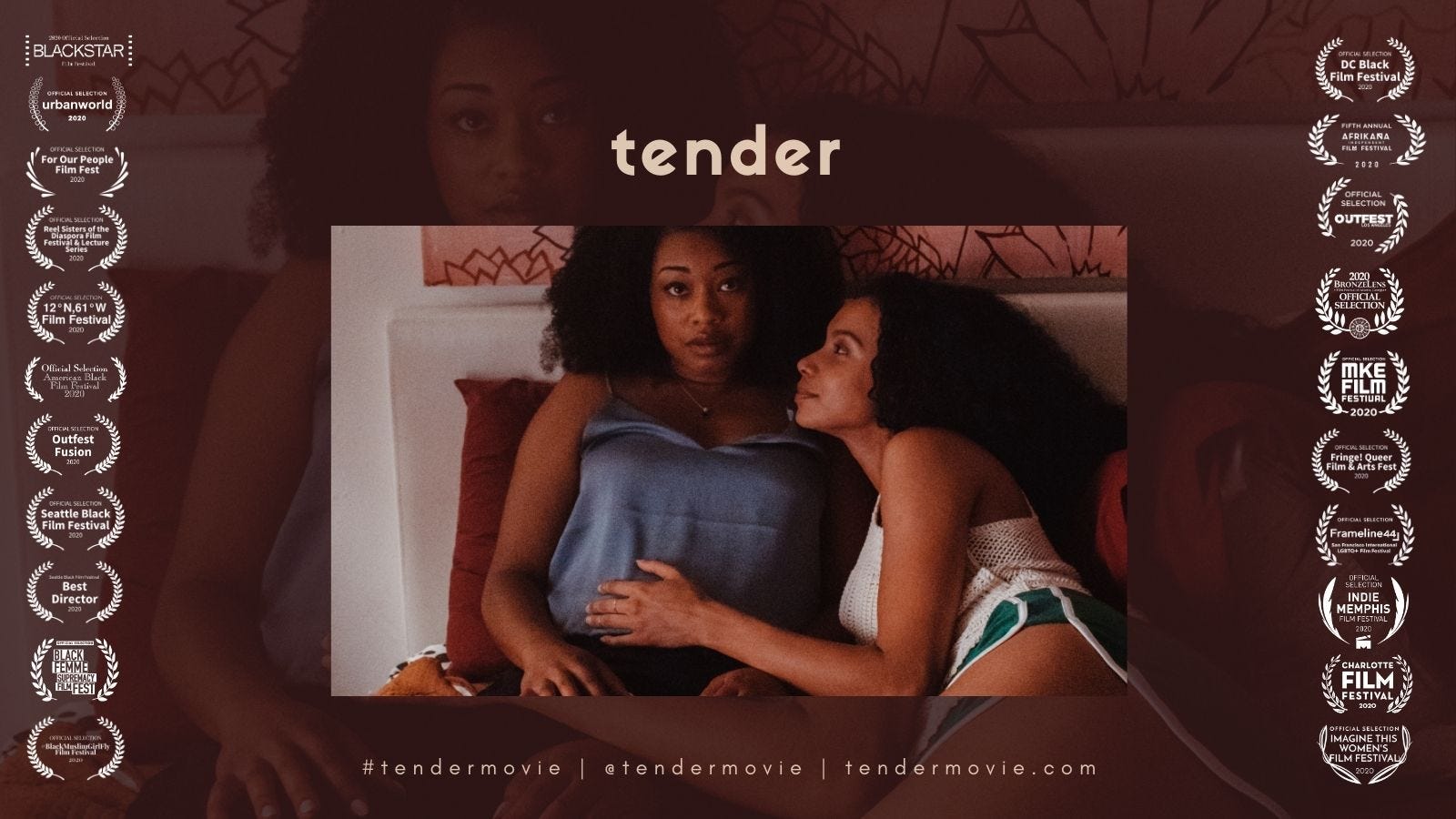
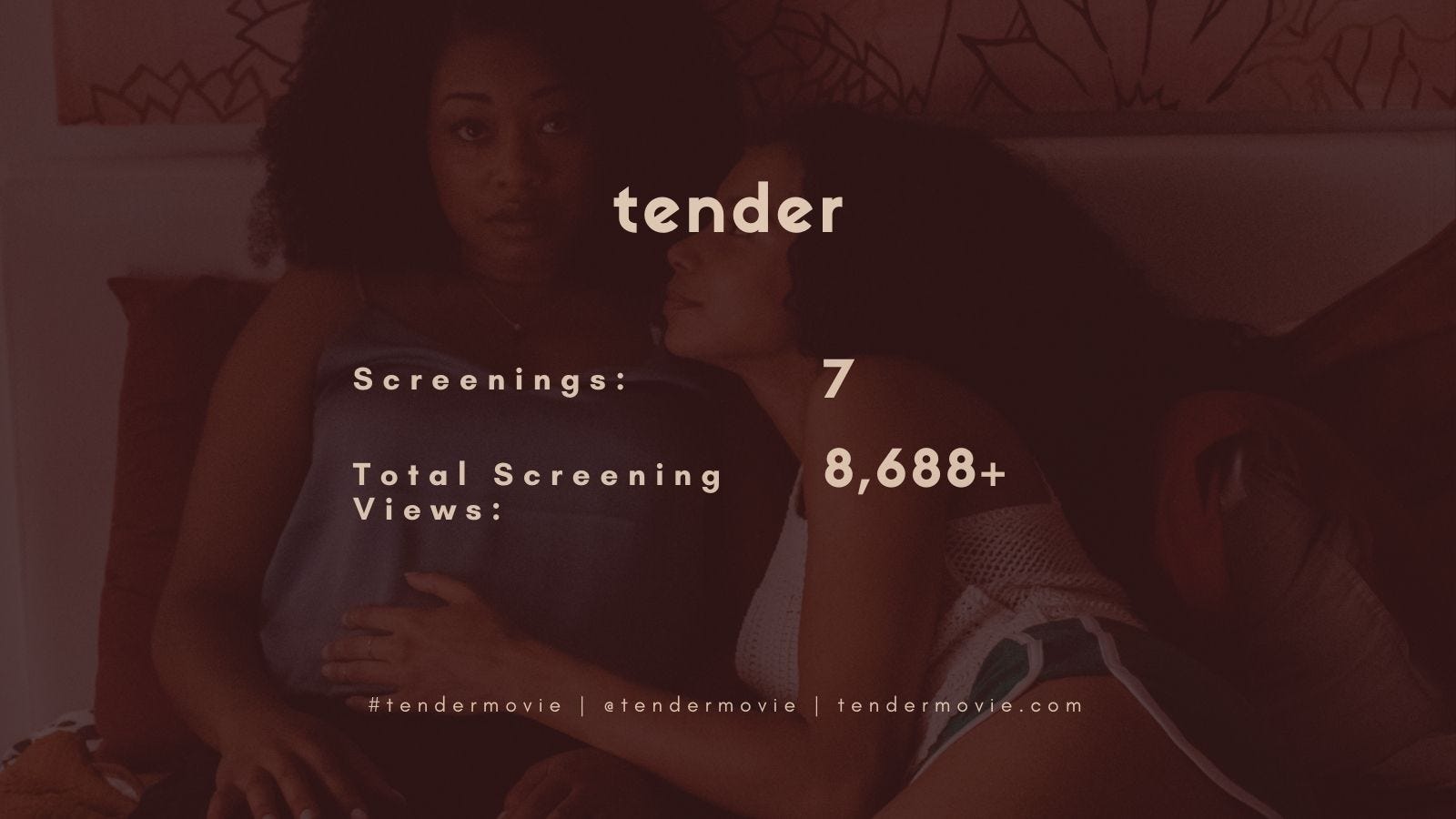
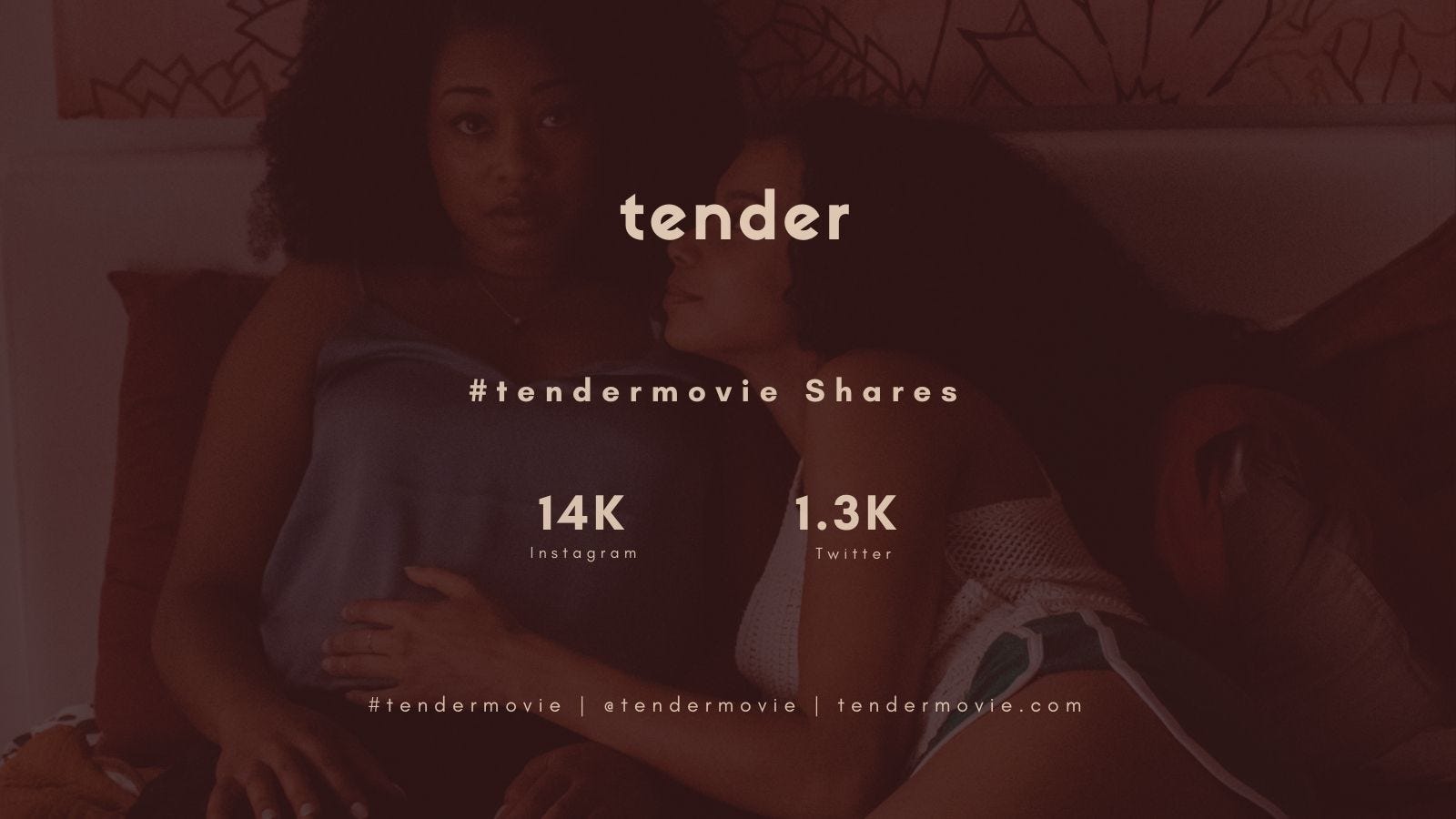

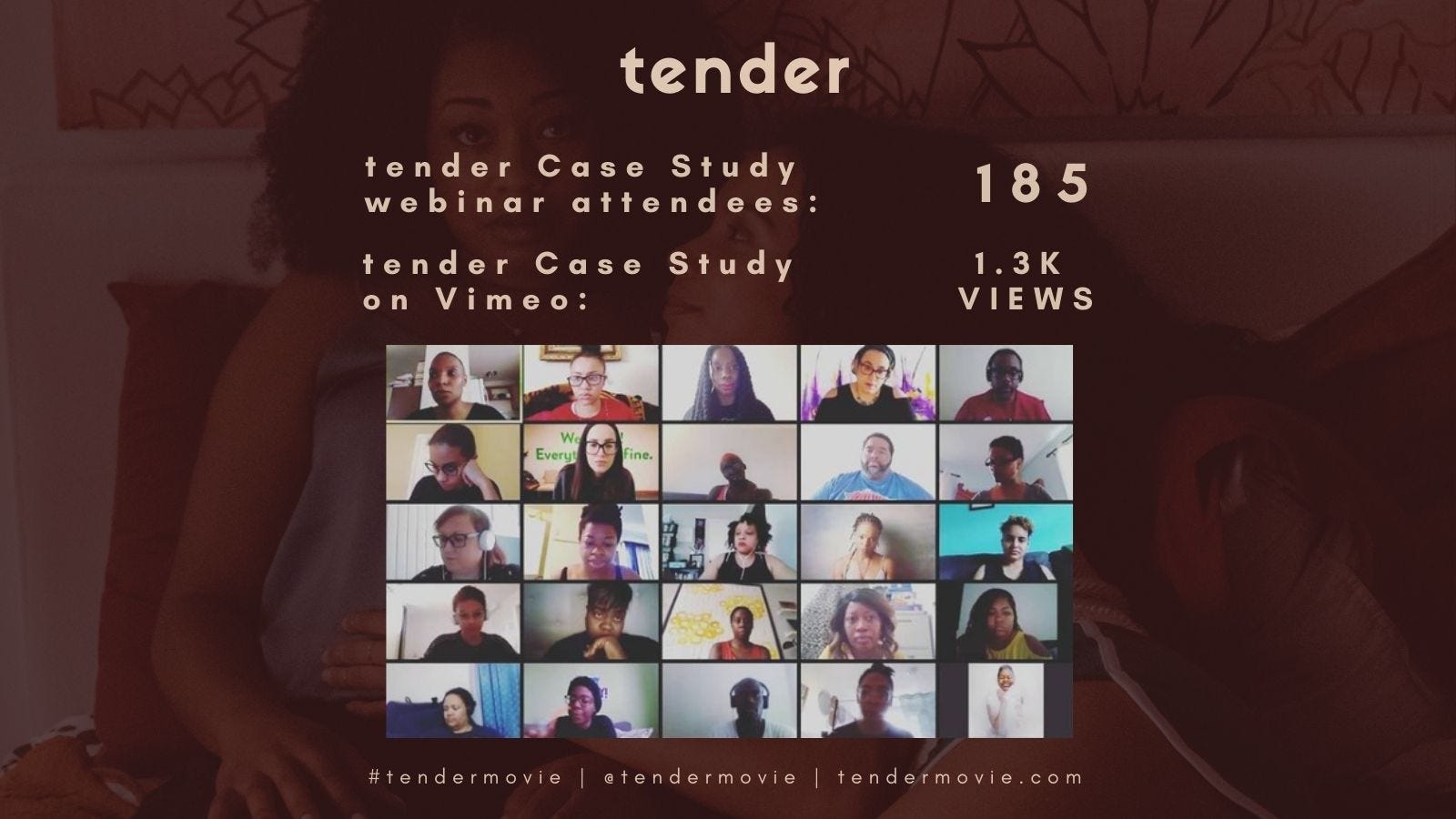
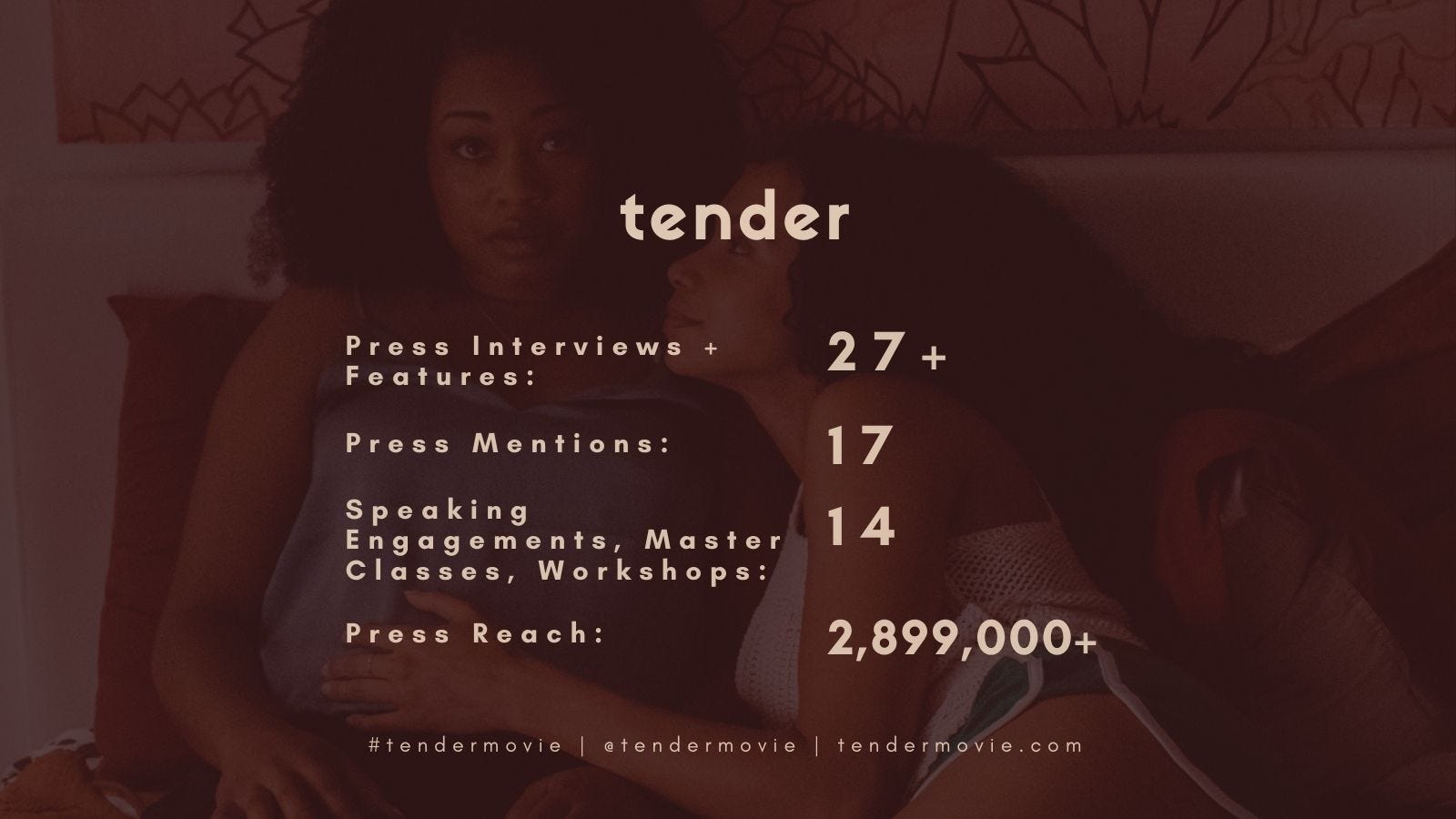
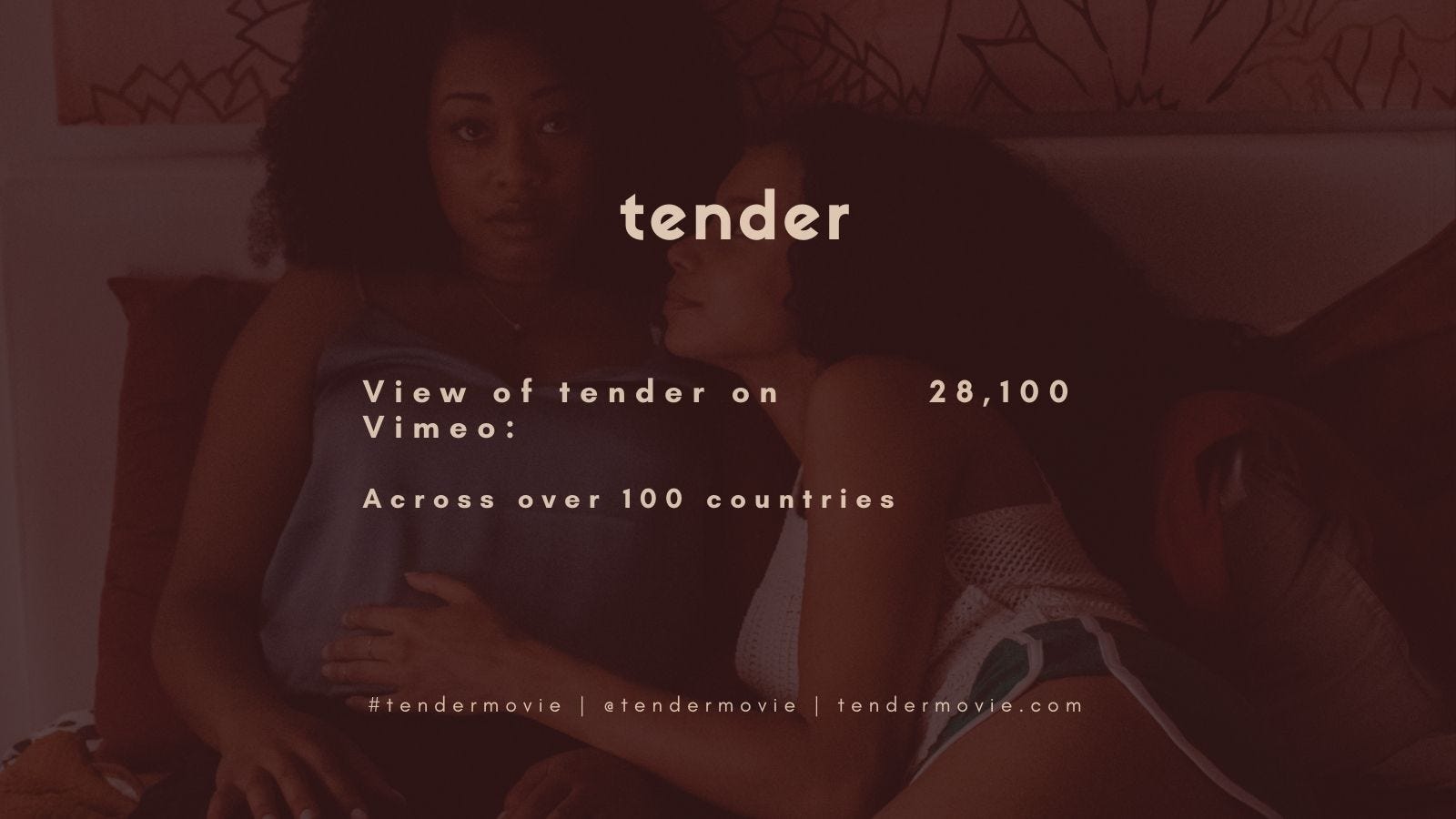
wrap-up
You can watch tender at tendermovie.com, and here’s our extended soundtrack and the original case study we did for the film.
So that’s how we financed, produced, and released our short film tender. We wanted to be transparent about our process in hopes to encourage others to make and release their work. You got this.
Stay connected! New courses + tools always coming soon!!
Sign up for our Lab List to get early access to new Create Daily Lab launches, events, opts. and more! We’re always cooking up new ways to make sh*t easier for storytellers like you.




